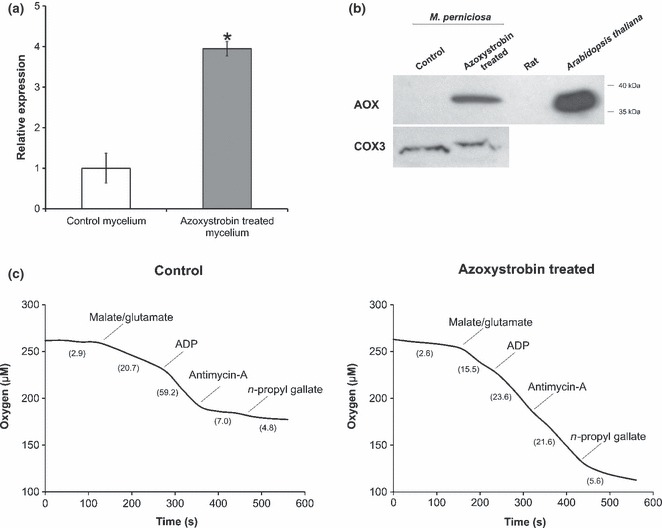Fig. 1.

Mp-aox gene expression, protein production and alternative oxidase (AOX) activity are well correlated in Moniliophthora perniciosa. (a) Relative expression levels of the Mp-aox gene in azoxystrobin-treated vs nontreated cells of the necrotrophic hyphae analyzed by quantitative PCR assays. The β-actin gene was used as an endogenous control (Student’s t-test: *, P < 0.01; Error bars represent standard deviation −SD). (b) Immunoblotting assay showing the presence of the Mp-AOX protein in mitochondria isolated from azoxystrobin-treated mycelium of M. perniciosa. No signal was detected in mitochondria of nontreated hyphae. The subunit 3 of the cytochrome c oxidase complex (COX3) was used as endogenous control. Rat and Arabidopsis thaliana mitochondria were used as negative and positive controls, respectively. (c) Oxygen consumption by purified mitochondria from the necrotrophic mycelium of M. perniciosa. Mitochondrial suspensions were added to the oxygraph chamber containing the reaction medium and were energized with 10 mM malate/glutamate and 1 mM ADP. AOX activity was assessed in the presence of antimycin-A (10 μM), as the remaining respiration inhibited by n-propyl gallate (100 μM). Mitochondrial oxygen consumption of nontreated hyphae showed high sensitivity to antimycin-A, but was unaffected by n-propyl gallate. In contrast, mitochondrial oxygen consumption of azoxystrobin-treated cells was poorly affected by antimycin-A, but greatly inhibited by n-propyl gallate. The numbers in parentheses represent the oxygen consumption rates in nmol min−1 mg−1 protein. In all of these assays, azoxystrobin-treated cells were incubated with 75 μM azoxystrobin for 4 h. Control refers to nontreated mycelium.
